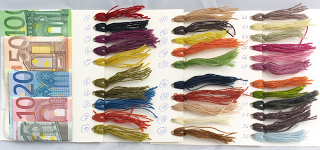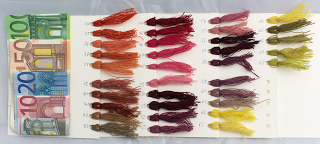Search the Blog
Latest Comments
Bounty Hunter Seeds
Tomato Seeds.
02. November 2024
Thank you for taking the time to share such valuable insights! This post is packed with helpful info...
Miriam Griffiths
Blog Pause...
01. November 2024
Hope you have a most wonderful time! One day, I really should get organised and join you.
Katrin
Cardboard Churches!
18. Oktober 2024
I didn't know there's foldable models - I will have a look into that, thank you!
Katrin
Cardboard Churches!
18. Oktober 2024
I'm very happy that you enjoyed it, and hope you will have lots of fun with the models! Hanging them...
Natalie Ferguson
Cardboard Churches!
17. Oktober 2024
Isn't this the happiest thing I've met today! You may guess that one or two will be winging their wa...
The Colour Dilemma.
As the longterm readers here know, I frequently work together for all things textile with Sabine from the Wollschmiede, my dyer of choice.
Sabine has been working on colour sample cards for her range of colours this winter, and she is currently at sample colour 68 - with more to come in the future, if I know her at all. And she is now getting the first requests for sample cards.
There's a problem, however. Making a sample card takes yarn - and time. Especially time. And providing a sample card or even a full set of sample cards with the full range would be keeping her from other work - and would have to be quite, quite costly.
The obvious solution is to have a digital photo version of the cards, just like a lot of other shops have, where you can download a photo or a .pdf file to see the colour range. But if you have ever taken a look at one of these, you also know the typical disclaimer - your monitor colours may vary, and there's no way to be sure that the colour you see will really be the colour you get. (Well, apart from the obvious slight changes to colours from dye lot to dye lot regardless of whether you do natural or chemical colours.)
This is due to the nature of the colour system used on monitors. The RGB system has three colours, red, green and blue. Mixing these can get you all the other colours (or at least enough that you won't miss any). You can also adjust your monitor settings - there's usually a menu somewhere in the system settings where you find three sliders to change the values (the saturation) of the three colours. (If you want a longer, in-depth explanation, you can find one here at Wikipedia.)
So while your monitor might not show all the colours correctly initially, it is technically possible to adjust the settings to at least get a good, if not perfect, match. High-end monitors and graphics professionals use a calibration device to make sure that what they see is what they will get (even if they print it), but this is of course not feasible for us ordinary mortals.
Now, if I'm only taking a photo for myself, I can always place something colourful that is mine beside the thing and then adjust the monitor (or the colours in the picture) to match my colour-matchy object. But if the thing is to be sent out... that makes things a bit more difficult.
So Sabine and I thought about things, and I finally found a solution. It's the low-key approach (in German, I would jokingly call it a "Hausfrauenlösung" - the housewife's solution, something that is simple and practical yet very effective). The colour match addition to the photo. Something that almost everybody that will be interested in getting the colour sample cards for an order from Sabine will have, or be able to obtain at no additional cost. The Something available almost everywhere in Europe, where it's used in thousands every day. The Something that comes in blue, red and orange as well as two shades of green (one more easily available than the other). The Something with colours fixed and stable enough that it should be possible to get a good match - or at least see how realistic the colours displayed are.
Euro notes.
So here I present to you the Money Matching Scheme for the colour sample cards - and if you like, give the colour adjustment a try and let me know if it worked for you!
Sabine has been working on colour sample cards for her range of colours this winter, and she is currently at sample colour 68 - with more to come in the future, if I know her at all. And she is now getting the first requests for sample cards.
There's a problem, however. Making a sample card takes yarn - and time. Especially time. And providing a sample card or even a full set of sample cards with the full range would be keeping her from other work - and would have to be quite, quite costly.
The obvious solution is to have a digital photo version of the cards, just like a lot of other shops have, where you can download a photo or a .pdf file to see the colour range. But if you have ever taken a look at one of these, you also know the typical disclaimer - your monitor colours may vary, and there's no way to be sure that the colour you see will really be the colour you get. (Well, apart from the obvious slight changes to colours from dye lot to dye lot regardless of whether you do natural or chemical colours.)
This is due to the nature of the colour system used on monitors. The RGB system has three colours, red, green and blue. Mixing these can get you all the other colours (or at least enough that you won't miss any). You can also adjust your monitor settings - there's usually a menu somewhere in the system settings where you find three sliders to change the values (the saturation) of the three colours. (If you want a longer, in-depth explanation, you can find one here at Wikipedia.)
So while your monitor might not show all the colours correctly initially, it is technically possible to adjust the settings to at least get a good, if not perfect, match. High-end monitors and graphics professionals use a calibration device to make sure that what they see is what they will get (even if they print it), but this is of course not feasible for us ordinary mortals.
Now, if I'm only taking a photo for myself, I can always place something colourful that is mine beside the thing and then adjust the monitor (or the colours in the picture) to match my colour-matchy object. But if the thing is to be sent out... that makes things a bit more difficult.
So Sabine and I thought about things, and I finally found a solution. It's the low-key approach (in German, I would jokingly call it a "Hausfrauenlösung" - the housewife's solution, something that is simple and practical yet very effective). The colour match addition to the photo. Something that almost everybody that will be interested in getting the colour sample cards for an order from Sabine will have, or be able to obtain at no additional cost. The Something available almost everywhere in Europe, where it's used in thousands every day. The Something that comes in blue, red and orange as well as two shades of green (one more easily available than the other). The Something with colours fixed and stable enough that it should be possible to get a good match - or at least see how realistic the colours displayed are.
Euro notes.
So here I present to you the Money Matching Scheme for the colour sample cards - and if you like, give the colour adjustment a try and let me know if it worked for you!
Comments 2
Greetings
I think that your Hausfrauenlösung is ingenious. I tested your pictures on my professionally color calibrated screen, and the colors in the second picture are almost a perfect mach to the Euro notes. The first picture was a little bit light, but not much. And with the notes in hand, one can always compare the colors, even if one's screen is not calibrated.
Unfortunately I couldn't print the pictures to test them that way.
I hope others would use this too!
Yours,
Elisheva





